Abstract
In order to improve the energy efficiency of multi-actuator pneumatic systems, a control scheme for the recovery of exhausted compressed air is designed and studied herein. This paper explains the procedure for the development of the balanced operation of a multi-actuator pneumatic system through the collection and reuse of exhausted compressed air. Compared with traditional motion control of pneumatic actuators, significant energy savings can be achieved, while the dynamic behavior of the cylinders from which the exhausted air is collected is maintained.
1. Introduction
Energy efficiency implies a set of terms that describes the quality of energy use. Energy savings should not be equated with savings or reduced consumption resulting from either a lack of energy to perform an appropriate activity or an excessive energy price. Energy efficiency should be understood as a set of organized activities carried out within the defined energy system. The aims of these activities are to reduce the input energy consumption, harmful gas emissions, and energy costs. However, the level of service performance or the creation of a new product in the production process within the defined system needs to remain unchanged.
In a broader sense, energy efficiency represents everything related to energy losses, meaning that the concept of energy efficiency can be reduced to a simple equation:
Energy losses occur during transformations, transmission, distribution, or final use. Energy losses can be reduced in a variety of ways and using several techniques; however, they can never be equal to zero. The first three processes mainly depend on the applied technology, while the last one depends on applied technical or non-technical activities.
1.1. Energy Efficiency of Pneumatic Control Systems
Modern industrial processes are almost impossible to comprehend without the application of pneumatic systems. These systems consist of devices or machines that use compressed air or vacuums in their operation. Reasons for the widespread use of compressed air as a working fluid in industry include its:
- Low purchase price;
- Easy availability;
- Long component lifetime;
- Compliance with environmental regulations;
- Possibility of working in hazardous environments;
- High actuator speeds.
Despite its advantages, due to improper use, compressed air can become one of the most expensive forms of energy for performing work in industrial plants. In most factories, only one part of the total compressed air is efficiently used [1,2,3,4]. This creates the need to pay close attention to its proper use and increase the energy efficiency of compressed air systems [1,2,3,4,5,6,7,8,9,10,11,12,13,14]. In reference [6], three possible ways to improve the energy efficiency of a compressed air system were identified: preventing energy losses [8], decreasing energy consumption [5], and reducing energy waste [9]. In accordance with the previously mentioned factors, in reference [12], pulse-width modulation (PWM) control combined with other techniques was used for reduction of compressed air consumption. A proposal for a component for compressed air leakage reduction is outlined in reference [13]. In order to reduce compressed air consumption, the use of different types of pressure regulators is presented in references [5,14].
An energy-efficient compressed air system is the result of good design, control, and maintenance in order to ensure minimal pressure losses in the distribution system, optimal quality of the compressed air, and energy-efficient use of compressed air at points of use. Thus, a systematic approach to the design of a compressed air system should enable reduction of energy losses in the system, drive energy savings, allow for a more reliable operation of the system, provide a longer lifespan for the system components, reduce the system’s operation costs, and improve environmental protection.
If the compressed air system is not energy-efficient, the costs per unit of the produced compressed air will increase and the work of the pneumatic actuators will not be appropriate. Therefore, the system function will become endangered and the service life of the components will be reduced.
In order to determine the energy efficiency indicator for compressed air systems, the production, distribution, and consumption of compressed air must be analyzed. Compressors, as a production part of compressed air systems, convert input energy into the energy of the compressed air, which is then distributed through the pipelines (the distribution part of the compressed air system) to the point of use (the executive parts of the compressed air system). At those points, useful work is output. In all of these system parts, there are potential energy losses. Accordingly, the energy efficiency indicator of pneumatic control systems can be expressed as an efficiency rate η in the form of
η = ηSOURCE × ηTRANSPORT × ηCONSUMPTION
Compared to the degree of hydraulic system efficiency [15,16,17,18], which ranges up to 66% [15,16], the efficiency rate of compressed air systems is much lower. The value of energy savings in the pneumatic control system is variable [19] and depends on the part of the system. With some actuators and under some operating conditions, the savings can be up to 50% [20].
1.2. Concept of Increasing Energy Efficiency of Pneumatic Systems with Recovery of Compressed Air
The pressure in a cylinder’s working chamber is gradually increased and the maximum pressure level is reached only when the cylinder rod reaches its end position. When the direction of movement changes, in the backstroke all air from the working chamber of the cylinder is released into the atmosphere, which results in a huge loss of compressed air, with enough potential energy to be used for additional operation. The basic principle for reusing (recuperating) the compressed air is shown in Figure 1.
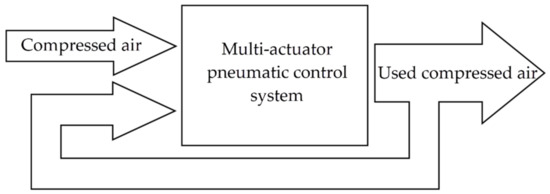
Figure 1.
The principle of compressed air reuse.
The compressed air recovery principle, which has been applied for a while [21], explains how it is possible to create a pneumatic control system with an additional compressed air tank after it is used in the cylinder. The collected air can be used to drive the same, or some other cylinder, in the system. The pneumatic scheme for the collection of exhausted air is shown in Figure 2.
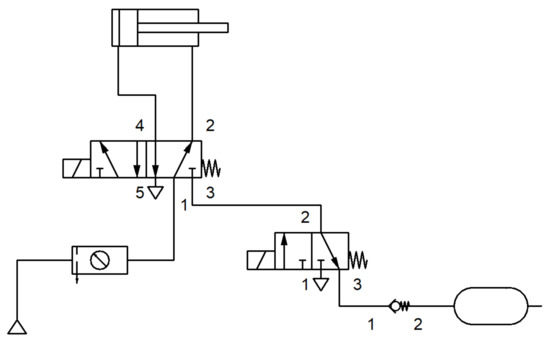
Figure 2.
Pneumatic control scheme of the system for reclaiming exhausted air.
The reclaimed air can be used in two ways. The first way is to use air from the extra tank to drive actuators that require a lower pressure level than the input pressure (compressed air system with different pressure levels in its subsystems). A lower air pressure can also be used for cleaning, drying, and other similar operations. In reference [21], an additional tank is used to reclaim exhausted compressed air. The influence of the reclaimed air on the work of the pneumatic cylinder from which the air is reclaimed is also considered. The system for collecting exhausted air, besides an additional tank, also includes an electrically activated directional control valve that directs the air from the chamber to either an additional tank or the atmosphere. For each cylinder, one electrically operated directional control valve and one non-return valve are needed to collect the air from its chambers. To control the operation of this valve, it is necessary to measure two pressures and then determine the pressure difference in the exhausted chamber and the current pressure values in the additional storage unit. For each cylinder, the lowest value of this pressure difference is determined, which does not lead to the appearance of the stick–slip effect. According to the results, the installation of a pneumatic control system for reclaiming exhausted air does not endanger the stability of the operation but does reduce the cylinder speed.
The second way is to use a pressure booster to increase the pressure of the collected air to the appropriate level [22,23,24]. The shortcoming of this system is the need to use an additional, higher-pressure air tank. The main advantage is the possibility of obtaining a pressure that allows the use of the exhausted air in any part of the control system.
For collecting exhausted compressed air from a multi-actuator system, the pneumatic installation and the control are more complex. In this paper, one such system is shown. The basic idea is that the collected air from the additional tank is used for the backstroke of a cylinder that consumes most of the air in the given system.
The main goal of this paper is to explain the development of an algorithm for a systematic approach to implementation of compressed air recovery, and achieving the operation in a balanced mode. It will be possible to apply this approach in almost all multi-actuator pneumatic control systems, where the pressure level in the additional tank must be considered [25].
1.3. Layout of the Paper
This paper is organized in the following way: After the introduction, Section 2 presents the experimental setup, called the circular manipulator. In Section 3, realized experiments are presented with the purpose of determining the minimum pressures required to drive each actuator, and the recovery of the compressed air. The obtained results are discussed in Section 4. Finally, the most important conclusions are derived in Section 5.
2. Experimental Setup
Experiments related to increasing the energy efficiency of pneumatic control systems were performed on a pneumatic circular manipulator [5,26]. It was developed at the Faculty of Technical Sciences, University of Novi Sad, Serbia, and is now used as a laboratory tool in research and education.
The above-mentioned manipulator performs simple operations, typical for industrial handling of workpieces, such as excluding workpieces from the storage unit, transferring workpieces to a new workplace, and restoring to the intended location [26], independently, or in combination with another control system, e.g., an industrial robot. Accordingly, it is purposely developed as a modular setup, which can be adapted to different types of pneumatic control by simple transformations [26]. It can be used to simulate various situations that may occur in industrial processes and to execute different experimental tests. An example of such an experiment is shown in reference [5], which describes improving energy efficiency by using a new, automatically controlled pressure regulator that provides operating pressure modification in real time, in accordance with different weights of the workpieces that may appear in random order. In this paper, the manipulator is used as part of the experimental setup for determining the possibility of achieving balanced operation of the compressed air recovery system and improving its energy efficiency. In this case, only one type of workpiece is used.
2.1. Description of the Manipulator Operation
The pneumatic circular manipulator is shown in Figure 3a. Workpieces were of cylindrical shape, 100 mm in height, 80 mm in diameter, and weighed 4 kg, and were placed in a vertical storage unit. The capacity of the storage unit is six workpieces.
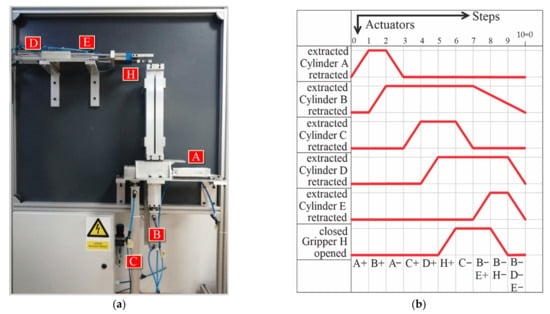
Figure 3.
Pneumatic circular manipulator: (a) hardware realization. Reproduced from references [5,26]; (b) travel-step diagram. Reproduced from reference [5].
The basic cycle of the manipulator operation is as follows:
- In the first step, the piston of the horizontally mounted double-acting cylinder (Figure 3a, position A) extracts and pushes one workpiece to the lifting position.
- Then, the vertically mounted double-acting cylinder (Figure 3a, position B) extracts and accepts the remaining five workpieces from the storage unit in order to ensure the smooth return of the cylinder A to its initial position. This cylinder is used to prevent the strong impact that the workpieces would create in the case of fast declining.
- The piston rod of the second vertically positioned double-acting cylinder (Figure 3a, position C) is extracted in the next step and lifts a workpiece to the top level. At this level, there is also a horizontally placed, multi-position cylinder made of two double-acting cylinders of identical characteristics (Figure 3a, positions D and E), which enable the realization of three different positions. The multi-position cylinder at its right end carries the gripper for gripping the workpieces (Figure 3a, position H).
- In the next step, the piston rod of cylinder D is extracted, and the gripper is brought to the position for taking the workpiece. Then, the clamp H closes and accepts the workpiece.
- After successfully accepting the workpiece, cylinder C is retracted, and cylinder B is then retracted. At the same time, cylinder E is extracted, which brings the workpiece to the top of the vertical storage unit. Gripper H opens and releases the workpiece that moves through the storage unit under the force of gravity.
- In the last step, the piston rods of cylinders D and E are simultaneously returned to their initial positions. This completes one working cycle. By repeating the previously described cycle, the workpiece circulation through the manipulator is enabled, hence the name.
To allow for easier understanding of the manipulator operation, Figure 3b shows a travel-step diagram.
2.2. Initial Pneumatic Control Scheme
The initial pneumatic control scheme, together with the scheme for connection of the inputs and outputs of the PLC, is shown in Figure 4. As the actuators, double-acting cylinders of 100 mm stroke and 32 mm diameter (in Figure 3 and Figure 4 marked with A, B, D, and E—order no. DNC-32-100-PPV-A, by Festo), double-acting cylinder with the stroke of 600 mm and a diameter of 32 mm (in Figure 3 and Figure 4 marked with C—order no. DNC-32-600-PPV-A, by Festo) and the pneumatic gripper (order no. HGP-25-A, by Festo) were used. For directional control, bistable electrically operated valves (order no. JMFH-5-1/8, by Festo) were used. Magnetic reed sensors were used to detect the end position of the cylinder and the locked position of the gripper. On all cylinders, the flow of compressed air on both ports could be regulated using the one-way flow control valves (order no. GRLA-1/8-QS-6, by Festo). For the preparation of compressed air, a service unit (order no. MS6-LFR-3/8-D7-ERM-AS, by Festo) was used. Cylinders D and E were framed by an intermittent rectangular shape because together they comprised a multi-position cylinder.
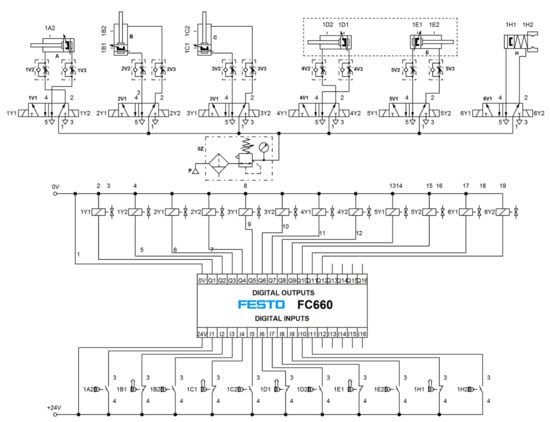
Figure 4.
Initial pneumatic control scheme.
The PLC (Festo FC660 Standard [27]) was used to control the system, and program environment FST 4.10 [28,29] was used for programming, while serial communication between PLC and PC was realized through RS232.
3. Conducting the Experiments
In order to achieve the recovery of compressed air, it is necessary to determine the minimum pressure values needed for the start of motion of individual cylinders. Thus, this section consists of two parts:
- The first part (Section 3.1), which refers to the determination of the minimum values of pressure necessary for the operation of pneumatic cylinders;
- The second part (Section 3.2), which deals with compressed air recovery in the closed circuit.
3.1. Determination of Minimum Pressure Values Necessary to Drive the Actuators
The aim of the first experiment was to find a minimum pressure value of the air entering the chamber of a particular cylinder in which the stick–slip effect did not occur. In order to obtain accurate measurements, the system was decomposed into several simple subsystems. Each subsystem comprised one or two cylinders that executed one particular part of the cycle of operation of the manipulator. Subsystems isolated for experiments were presented as follows:
- Extracting the piston rod of cylinder A under the load of the workpiece;
- Extracting the piston rod of cylinder B partially with the load of the workpiece;
- Retracting the piston rod of cylinder A without the load of the workpiece;
- Retracting the piston rod of cylinder B under the load of the workpiece;
- Extracting the piston rod of cylinder C under the load of the workpiece;
- Retracting the piston rod of cylinder C without the load of the workpiece;
- Extracting the piston rod of cylinder D under the friction force produced by the construction itself;
- Extracting the piston rod of pneumatic cylinder E under the load of the workpiece;
- Retracting the piston rods of pneumatic cylinders D and E under the friction force produced by the construction itself.
Workpieces, due to their mass, produce additional friction, which, to some extent, affects the operation of the system in which the workpiece slides along a certain surface of the manipulator. This additional load was particularly noticeable in the first subsystem.
In order to reduce the impact of the compressed air supply lines’ length, the equipment was placed as close as possible to the cylinder ports on which the experiment was carried out. Determining the minimum required pressure was conducted in two series:
- In the first one, we started from the lowest pressure value (0.5 bar). It was gradually increased until the occurrence of so-called stick–slip effect;
- In the second one, we started from the highest recommended pressure value [30], typical for industrial use (6 bar), and it was gradually decreased until the stick–slip effect occurred.
Obtained values were read automatically using a pressure sensor, PLC, and a computer. Additionally, visual reading and recording of values from the pressure gauge was performed. The following pieces of equipment were used for measurement:
- Two mechanical pressure regulators with pressure gauge, order no. 539756, from the Festo didactic set;
- Three 5/2-way panel mounted valve with selector switch, order no. 152862, from the Festo didactic set;
- Pressure gauge, order no. 152865, from the Festo didactic set;
- Two pressure sensors, by DANFOSS, order no. MBS 3000 [31];
- PLC, by Festo, order no. FC660 Standard;
- Personal computer.
In order to record the operation of the system and read the pressure value, a program for the PLC that gathers information from two pressure sensors (sensors measure the absolute pressure) was written. One was connected to the system and the other one measured the atmospheric pressure (together they represent a differential pressure gauge). The difference between these two values represents the value of the overpressure in the system. Through serial communication, the PLC sends this value to the computer; using Realterm software, data are stored in a format suitable for further analysis.
3.1.1. Cylinders A and B
The first experiment was carried out on cylinder A. The minimum necessary pressure was obtained for extracting the cylinder rod, i.e., when excluding a workpiece from a vertical storage unit. Resistance during the extraction of the cylinder is the friction force created by the piston rod slide, and the workpiece when making contact with the sliding surface (Figure 5a). During the experiment, cylinder A was separated from the rest of the system and connected to the equipment, as shown in Figure 5b. The 1V1, PS, and M markings are a mechanical pressure regulator, a pressure sensor for automatic reading of the current pressure value, and a pressure gauge for additional, visual reading and monitoring of the current pressure value, respectively.
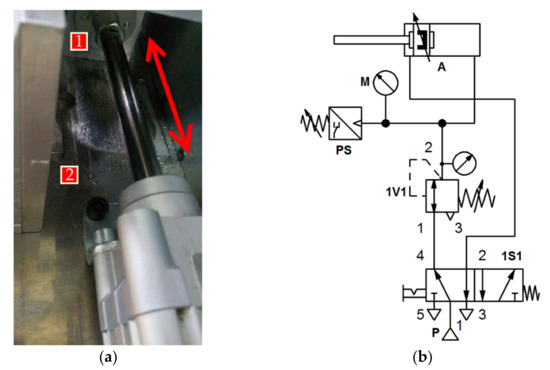
Figure 5.
(a) Additional load when extracting cylinder A piston rod—high friction: (1) installment for piston rod, (2) sliding surface; (b) determining the minimum pressure required to extract cylinder A piston rod.
The next experiment was carried out on cylinder B (Figure 6a). In this case, it was necessary to determine the minimum pressure that was sufficient to partially lift and hold the workpieces in a vertical storage unit (five pieces in total, since one of them had been previously excluded from the storage). The resistance when extracting the cylinder rod is the weight of these five pieces. The pressure regulator on cylinder A was set to a previously determined value. Cylinders A and B were separated from the rest of the system and temporarily connected to the testing equipment, as shown in Figure 6b.
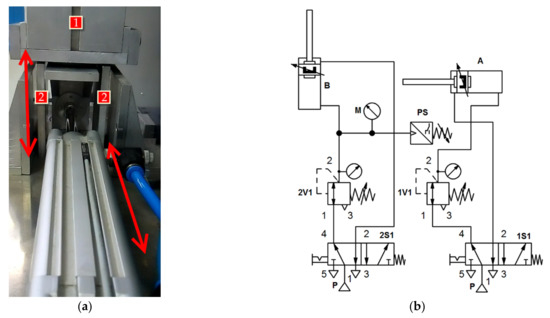
Figure 6.
(a) Holding the workpiece in the storage unit with cylinder B extracted: (1) workpieces, (2) installment for piston rod; (b) determining the minimum pressure required to extract cylinder B.
In the case of cylinder A retracting (Figure 7), as in the previous experiment, it was necessary to additionally connect cylinder B because its role is to hold the remaining five workpieces from the vertical storage. Its piston rod needed to be in the extracted position until cylinder A was retracted. The pressure regulator on the cylinder B was adjusted to a predetermined value, so that cylinder A could be retracted in the initial inner-end position. The resistance of the piston rod retracting represents the friction force generated by the extraction of the piston rod in contact with the sliding surface (Figure 5a).
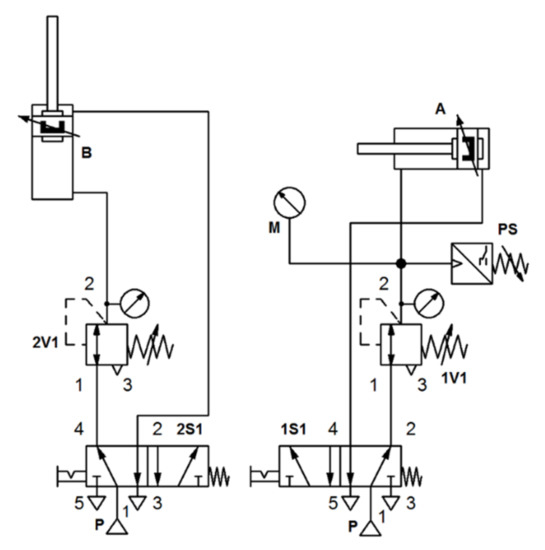
Figure 7.
Determining of the minimum pressure required for cylinder A retracting.
Determination of the minimum required pressure for cylinder B retracting was not necessary because it was returning to the initial inner-end position, under the influence of the weight of workpieces.
3.1.2. Cylinder C
Cylinder C raises the workpiece (Figure 8a) to the top level when extracting its piston rod, and when retracting, it is free of load. The resistance during the extraction of the piston rod is the weight of one workpiece. During the determination of the minimum necessary forces, this cylinder was separated from the rest of the system and temporarily connected to the testing equipment, as shown in Figure 8 (extracting cylinder C—Figure 8b—and retracting cylinder C—Figure 8c).
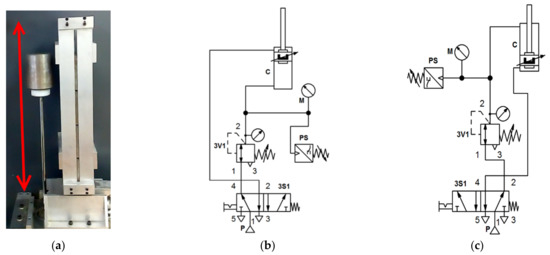
Figure 8.
(a) Lifting the workpiece; (b) determining the minimum pressure required for extracting cylinder C; (c) determining the minimum pressure required for retracting cylinder C.
3.1.3. Cylinders D and E
In order to determine the minimum pressure required to extract cylinder D, it was separated from the rest of the system and temporarily connected to the testing equipment, as shown in Figure 9b. The resistance of the piston rod extracting represents the friction force generated by the cylinder piston rod slide in contact with the sliding surface (Figure 9a).
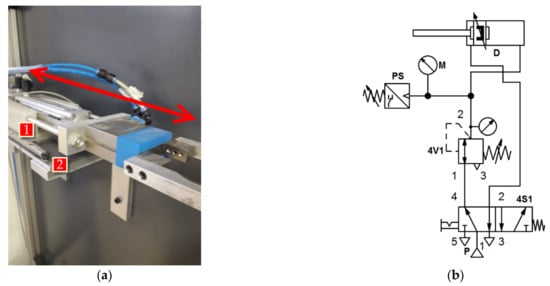
Figure 9.
(a) Additional load when extracting cylinder D piston rod—high friction: (1) slider, (2) sliding surface; (b) determining the minimum pressure required to extract cylinder D piston rod.
In the case of cylinder E extracting, the piston rod of cylinder D was extracted, the gripper was closed, and the workpiece was fixed. The resistance of the cylinder extracting is the friction force generated by the piston rod slide when making contact with the sliding surface, and the weight of the workpiece and the gripper (Figure 10). In order to determine the pressure, cylinders D and E and gripper H were separated from the rest of the system and temporarily connected to the testing equipment, as shown in Figure 11.
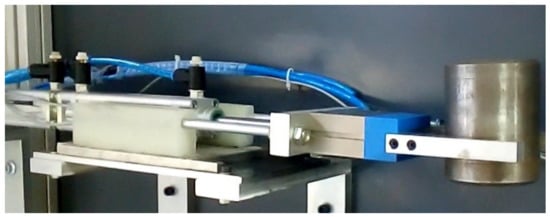
Figure 10.
Extracting of cylinder E—workpiece relocation toward the upper part of the storage unit.
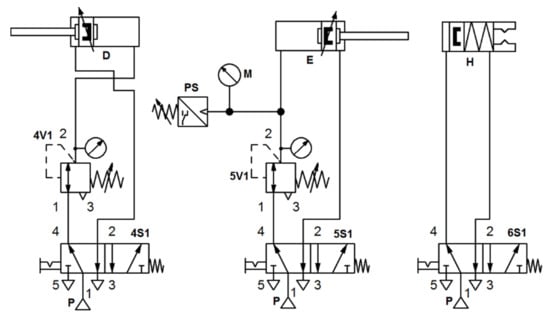
Figure 11.
Determining the minimum pressure required for cylinder E extracting.
As the piston rods of cylinders D and E, in the normal operating mode, were retracted into the initial inner-end position, at the same time they were separated from the rest of the system and connected to the equipment, as shown in Figure 12. In addition to the cylinders, a gripper was also connected, which was open in this case (workpiece was released) and whose weight, along with the force of friction generated by the piston rod slides in contact with the surface, created resistance.
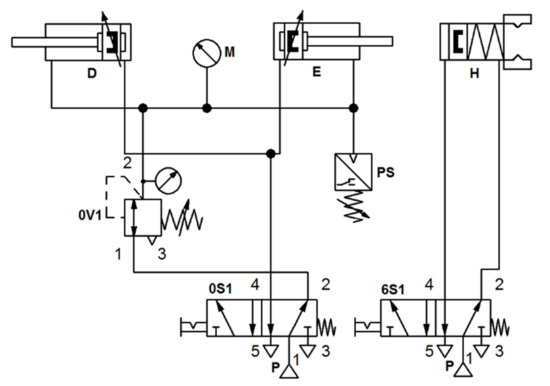
Figure 12.
Determining the minimum pressure required for retraction of cylinders D and E.
3.2. Recovery of the Exhausted Compressed Air
After determining the minimum necessary pressure values for the starting motion of each cylinder of the manipulator, a new pneumatic system for recovery of the exhausted compressed air was formed. This was accomplished by adding an additional tank in which the exhausted air was collected, instead of being released into the atmosphere. The air in the additional tank can only be collected if it does not jeopardize the operation of the basic system [25]. In addition, the newly formed system needs to be simple enough for both practical use and control.
3.2.1. Basic Idea and Development of the New System
As mentioned previously, the main goal of this paper was to verify the possibility of achieving balanced operation of the compressed air recovery system and improving its energy efficiency. The key task is finding the optimal method of collecting the compressed air and the optimal method of using the collected compressed air. If the amount of collected compressed air is insufficient, the system will once again need to use compressed air from the compressed air supply for several control operations. On the other hand, if the amount of compressed air is excessive, which can affect the system dynamics characteristics, the collected compressed air will need to be exhausted into the atmosphere. This also represents energy losses. Accordingly, balanced operation of the compressed air recovery system implies that once the system starts using the collected compressed air from the additional tank, it is used continuously. Additionally, the reduction of dynamic characteristics during actuator movement must be avoided and the operating capacity of the collected air must be preserved. This is achieved by keeping the compressed air pressure in the tank within boundary values:
- The lower limit value allows uninterrupted control operation for which it is intended;
- The higher limit value (53% of the input pressure value, from the compressed air supply [25]) must not be exceeded in order to prevent violation of the system dynamics characteristics.
In this case study, it is not difficult to conclude that the vertically positioned cylinder C, due to the length of its stroke, is the largest consumer of compressed air and low pressure, and/or minimum force values are required for its launch (extracting and retracting of the piston rod). Therefore, it was determined that the collected air from the tank should be used to retract the cylinder C piston rod and that the air should be collected from cylinders A, B, and D during the entire manipulator operating cycle. During the experimental testing, the input value of the pressure in the system was set to the highest recommended pressure value of 6 bar [30]. The idea is that the pressure is gradually lowered to a minimum possible value.
The main change in relation to the basic control system was made at cylinder C. Specifically, in the realization of the basic control system, two one-way flow-control valves were used to regulate the flow and speed of the cylinder movement in a way that throttled the exhausted air (meter-out control). Due to the specificity of the realization of the use of the collected air, i.e., the addition of new directional control valves, it was necessary to install a quick exhaust valve that was put into operation by extraction of the cylinder or when lifting the workpiece. By experimental testing, it was found that by using only a quick exhaust valve, the cylinder was extracted at a high speed, and that the workpiece dislocated from the mount at the top of the piston rod, which led to improper operation and delay. This problem is solved by switching to the throttling of inlet air (meter-in control). The final pneumatic control scheme is shown and described in detail in Section 3.2.2.
3.2.2. Pneumatic Control Scheme with the Recovery of the Exhausted Air
The aim of this experiment was to form a pneumatic system with the use of exhausted compressed air in order to obtain an energy-efficient system. This was enabled by the introduction of an additional storage unit for the reuse of exhausted air.
A pneumatic control scheme with the recovery of exhausted air is shown in Figure 13. Compared to the basic control scheme (Figure 4), several elements were added. The first one is the storage tank R for the collection of exhausted compressed air, with a capacity of 30 L. The exhausted air from cylinders A, B, and D was supplied to the tank. In order to prevent the return of air from the tank to these cylinders, non-return valves were installed on each line: 1V4, 2V4, and 4V4, order no. H-1/8-A/I, by Festo. At the outlet of the tank, one monostable, electrically activated 5/2 directional control valve, 0V1, order no. VUVS-L20-M52-MD-G18-F7-1C1, by Festo, was installed, which was turned into a 2/2 valve by blocking the outlet, and it activated only if the pressure value in the tank reached 53% of the inlet pressure value [25]. Furthermore, a pressure sensor PS, order no. SDE3-V1S-B-HQ4-2P-M8, by Festo, was installed, from which information is provided about the pressure value in the additional tank. Additionally, in the extension to the same line, a 3V7 pressure regulator was installed, which was used to adjust the minimum pressure value required for the backstroke of cylinder C. Between cylinder C and its respective directional control valve, a quick exhaust valve 3V4, order no. SE-1/8-B, by Festo, was installed, through which the air was discharged into the atmosphere at the piston outlet, along with two monostable, electrically activated 5/2 valves, marked as 3V3 and 3V5, order no. VUVS-L20-M52-MD-G18-F7-1C1, by Festo, which was turned into 2/2 valves by blocking the exhaust port. The 3V3 valve was activated only when the backstroke of the cylinder C piston rod was realized by compressed air coming directly from the supply. In this case, the pressure in the tank is below the minimum value. The 3V5 valve was activated only when the backstroke of cylinder C was realized with the compressed air coming from the additional tank. In this case, the pressure in the tank was within the appropriate limits.
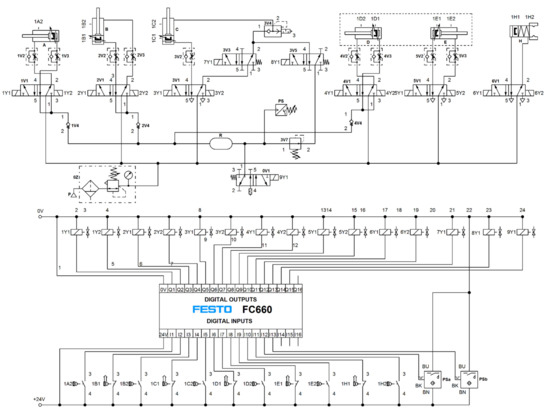
Figure 13.
Pneumatic control scheme with the recovery of the exhausted air.
4. Results and Discussion
4.1. Minimum Pressure Values Necessary to Drive the Actuators
The minimum input pressure required to extract the piston rod of cylinder A is 3.88 bar, which is equal to a force of 312.05 N. The obtained limit value is shown in Figure 14. It shows that the pressure gradually increased (when the operation started with a minimum value—a blue curve line) or reduced (when the operation started with a maximum value—an orange curve line) in a certain number of iterations. For each case, the dynamic behavior of the system was determined and, from both directions, the pressure value was also determined when a stick–slip effect occurs.
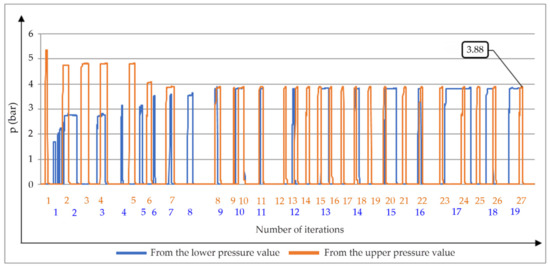
Figure 14.
Determination of the pressure limit value during cylinder A extraction.
The minimum required pressure and minimum required force were also determined for the other cylinders in an identical way. The obtained results are shown in Table 1.

Table 1.
Minimum pressure values required for manipulator operation.
Considering the safety of the system operation and possible variations in resistance forces, the values shown in Table 2 were adopted as the minimum values of the pressures required for the manipulator operation.

Table 2.
Adopted pressure values required for manipulator operation.
In order to ensure the continuous operation of the manipulator, a pressure value greater than, or equal to, the maximum limit value in Table 2 must be provided. In the case of extracting the cylinder A, this is a value of 4 bar. This defines the minimum value of the input pressure with which the manipulator, in the recovery mode, can operate without delays.
4.2. Compressed Air Consumption
The measurement of compressed air consumption was conducted by the Festo laboratory device Air Box [32]. It comes with a software package MSR, which enables the downloading of recorded data to a PC in a spreadsheet and graphic form.
The consumption measurement of the basic system was taken in the following way:
- The Air Box was installed immediately after the service unit, i.e., at the entrance to the system.
- The system pressure was set to 6 bar.
- In order to obtain accurate results, the manipulator was put into operation so that it was arbitrarily defined to perform 10 working cycles for one measurement.
- Data were recorded in the Air Box and then transferred to a PC in a spreadsheet (.csv file) and graphic (.jpg file) form.
- The graphs show the flow of compressed air in L/min (marked with a red curve) and pressure at the entrance to the Air Box (marked with a blue line), which is expressed as absolute pressure.
- In order to determine total compressed air consumption, the values shown in the graph need to be integrated to determine the surface below the curve (using the definite integral). Accordingly, the total compressed air consumption (in L), for one measurement, is calculated using the following formula:where is the total air consumption in l, is the time of measurement in s, is previous measurement time in s, is air flow in expressed in L/min, and air flow in expressed in L/min. Afterward, by dividing by the number of cycles, the consumption of compressed air was calculated for one working cycle.
- The measurement was repeated five times, and then, as the reference value, the mean arithmetic value of all the measured results was calculated. The deviation of all the results from the reference value was negligible.
Compressed air consumption measurement results for the basic cycle (one example of the five measured cycles) are shown in Figure 15. To allow for easier understanding of the graphics, one cycle of manipulator operation is highlighted with a black rectangular shape. The average consumption of compressed air for one cycle was 12.14 L.
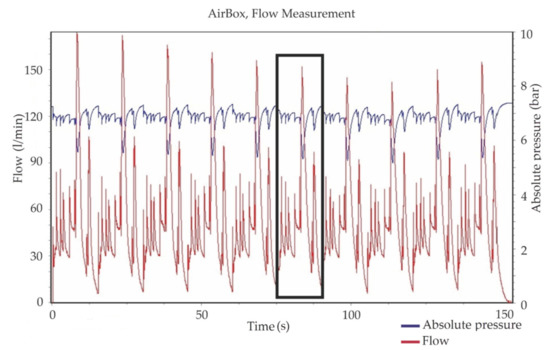
Figure 15.
Measurement results of compressed air consumption for the basic system.
The second step was to measure the consumption of the system with the recovery of the exhausted air for the backstroke of cylinder C. Two cases were analyzed:
- When the input pressure value was 6 bar;
- When the input pressure value was 4 bar (in accordance with the results obtained in the first part of the experiment).
For both cases, the manipulator performed 10 working cycles for one measurement. Calculation of the consumption of compressed air and determination of the reference value were carried out in the same way, as in the case of the basic system (without recovery).
The results of the compressed air consumption measurement for the system with recovery of the exhausted air (one example of the five measured), with an input pressure of 6 bar, are shown in Figure 16. The average compressed air consumption for one cycle is 9.43 L. In this way, a total of 2.71 L was saved per one working cycle of the manipulator, or approximately 22% of total consumption, which confirms that this method provides a more energy-efficient system than the standard one.
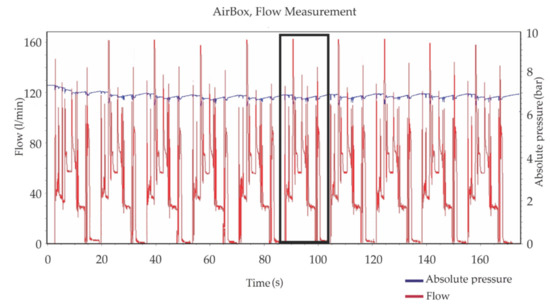
Figure 16.
Measurement results of compressed air consumption for the system with recovery of the exhausted air with input pressure of 6 bar.
The results of the compressed air consumption measurement for the system with recovery of the exhausted air (one example of the five measured), with an input pressure of 4 bar, are shown in Figure 17. The average compressed air consumption for one cycle was 7.6 L. Compared to the basic, initial control system, considering the minimum pressures required for the manipulator to operate (which were determined in the first part of the experiment), the total consumption of compressed air decreased by 4.54 L per one working cycle or 37% of the total consumption, which confirms that it was more energy efficient than the standard one.
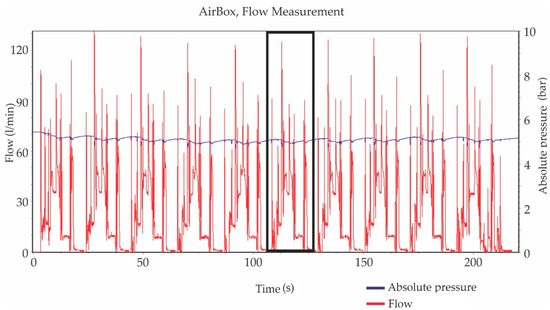
Figure 17.
Measurement results of compressed air consumption for the system with recovery of the exhausted air with input pressure of 4 bar.
The pressure value in the tank is most important for the recovery of exhausted air. It has already been established, in reference [25], that the pressure in the tank must not reach a maximum value of 53% of the input pressure value in order to prevent weakening of the dynamic characteristics of the actuator. In the given case, these were values of 3.18 bar (when the input pressure in the system equals 6 bar) and 2.12 bar (when the input pressure in the system equals 4 bar). Where the given values are exceeded, the additional valve 0V1 from the control scheme, as seen in Figure 13, must be switched on and a certain amount of air should be released into the atmosphere, which is a loss of energy.
The control system started to use the air from the additional tank from the value of 0.8 bar, but it was experimentally established that the system did not work reliably at values less than 1.2 bar and that, sometimes, there was a delay when returning cylinder C to the inner-end position, and, subsequently, it led to a malfunction of the entire system. These differences can be attributed to the appearance of additional loads during the combined operation of the entire system. It was already established that the minimum necessary pressures for starting one of the actuators were determined in such a way that the system was divided into smaller units and that each unit was observed separately. These values were taken as the starting points for the implementation of a new, more energy-efficient system and were additionally corrected experimentally. As a result, the boundary values of the pressure in the additional storage tank were determined and they were equal to:
- The lower limit value (after which the use of the collected air starts in order to initiate the backstroke of cylinder C) was set to 1.2 bar;
- The upper limit value (after which there would be a release of a certain amount of air from the tank to the atmosphere) was set to 2.12 bar (in case the input pressure in the system was 4 bar) or 3.18 bar (in case the input pressure in the system was 6 bar).
Supervision of the pressure change in the tank was carried out during 60 manipulator operating cycles and each time a value was recorded at the end of one cycle. The procedure was repeated three times. By comparative analysis of the results, we concluded that the deviation from the reference value was negligible (below 1%). Changes in pressure in the tank are shown in Figure 18 (when initial pressure was 6 bar) and Figure 19 (when initial pressure was 4 bar). It is important to mention that before the start of the first cycle, the tank was completely empty.
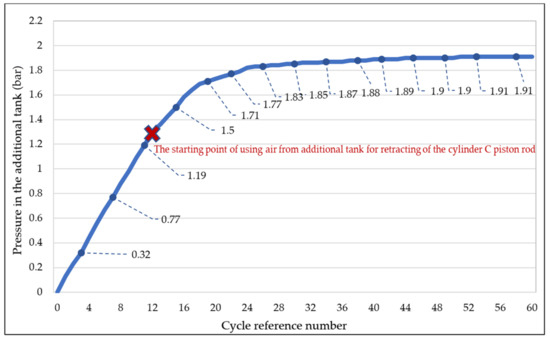
Figure 18.
Change in pressure values in the additional tank when the input pressure is 6 bar.
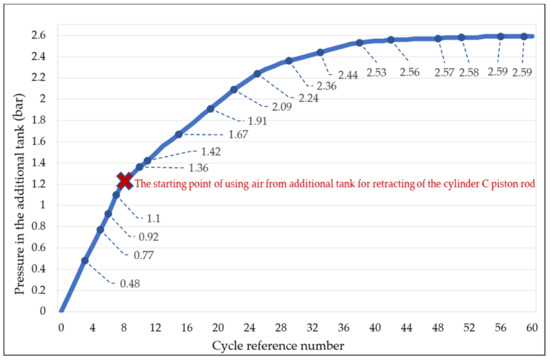
Figure 19.
Change in pressure values in the additional tank when the input pressure is 4 bar.
It can be seen in Figure 18 that the initial increase of pressure in the tank (when it was not in use, before the 9th cycle) was very large, approximately 0.14 bar per cycle. Then, when the reuse of air from the tank started, the rate of pressure increase gradually slowed down from about 0.6 bar per cycle around 20th cycle to a maximum of 0.03 bar and less per cycle after the 50th cycle.
Figure 19 shows that the initial pressure increase in the tank (when it was not used, up to the 14th cycle) was very large, approximately 0.11 bar per cycle. Then, when the reuse of the air from the tank started, the rate of pressure increase gradually slowed down from about 0.5 bar per cycle around 20th cycle to a maximum of 0.01 bar and less per cycle after the 50th cycle.
Thus, we created an energy-efficient pneumatic system that operated in a balanced mode because the pressure in the additional tank did not exceed the upper pressure value in any case, and there was no need for releasing the collected air. During the process, the dynamic characteristics of the system were not disturbed and the manipulator operated without any delay.
4.3. Systematic Approach for the Development of an Energy-Efficient System with Recovery of Compressed Air
Based on the obtained results and their analysis, an algorithm for a systematic approach to implementing compressed air recovery and achieving the operation in a balanced mode was developed. It is represented by a flow chart in Figure 20.
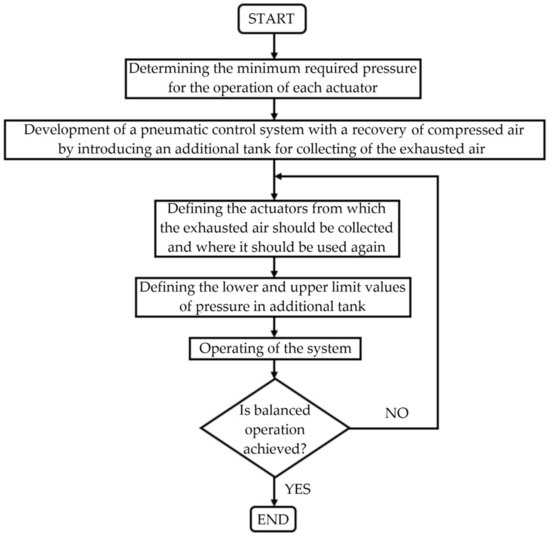
Figure 20.
Systematic approach for the development of an energy-efficient system with recovery of compressed air.
The developed algorithm consists of several steps:
- First, it is necessary to determine the minimal compressed air pressure values. Those values depend on the actuators and workpiece characteristics.
- In the next step, it is necessary to transform the initial pneumatic control scheme into a control scheme with the recovery of the exhausted air by adding appropriate components, such as non-return valves, 2/2-way valves, quick exhaust valves, pressure sensors, and pressure regulators. With the correct component connections, the newly obtained scheme must allow for collecting the exhausted air from some actuators (non-return valves allow compressed air flow only when directed to the additional tank) and reusing the collected compressed air for operation of some actuators (2/2-way valves allow either air supply from the additional tank or a compressed air supply, and the quick exhaust valves allow the compressed air to be exhausted from the actuator chambers in the appropriate time).
- Before starting the system, it is necessary to define boundary compressed air pressure values (the upper and lower limit pressure values) in the additional tank. The lower limit value needs to allow sufficient compressed air for starting the motion of the chosen actuators. The upper limit value must not exceed 53% of the minimally required input pressure value (determined in step 1).
- Finally, the system should be started. The system operation is constantly monitored and checked for malfunction and whether balanced operation is achieved (if the compressed air pressure value is kept within the defined limits). If balanced operation is not achieved, the algorithm is repeated from step 2.
5. Conclusions
This paper presents the development of an energy-efficient system with the recovery of compressed air.
Beside this new procedure, the following results were determined:
- The compressed air consumption of the recovery system at an input pressure of 6 bar, compared to the basic system, was reduced by 2.71 L per cycle of operation of the manipulator, which represented a 22% saving.
- When considering a systematic approach and determination of the minimum forces required to start the motion of the cylinders, a minimum pressure value of 4 bar was set for the input pressure of the recovery system, which enabled safe and undisturbed operation of the manipulator. The consumption of such a recovery system, compared to the basic system, was reduced by 4.54 L per cycle of operation of the manipulator, or by 37%.
- Balanced operation of the pneumatic control system was achieved because the pressure in the tank never exceeded the upper limit value, and there was no need for additional air discharge from the tank, which would result in additional energy loss. If the system were to start with a partially charged tank (to a lower pressure value), the backstroke of the cylinder C piston rod would be, from the very beginning, achieved by the collected air in the tank.
- With the accomplishment of this kind of recovery mode, the energy losses in the system, generated by the release of compressed air into the atmosphere, were minimal. They only appeared while lifting the workpiece and returning the piston rod to its inner-end position (cylinder C), gripping and releasing the workpiece (pneumatic gripper H), and moving the workpiece to the top of the storage tray and returning the piston rod to its forward-end position (cylinder E), because the exhausted air from those ports was not included in the recovery system.
- The main disadvantage of the proposed approach is the increase of the cycle duration period that occurred due to compressed air pressure reduction and changed in the system characteristics. The average time of a manipulator operating cycle with a recovery system with an input pressure of 6 bar, compared to the basic system, was increased by 1.8 s, or 12%. The average time of a manipulator operating cycle with a recovery system with an input pressure of 4 bar, compared to the basic system, was increased by 5.7 s, or 38%.
Based on the above advantages and disadvantages of this approach, it was concluded that its application was, in some systems, in accordance with users’ requests, reasonably justified, and that, in this way, an energy-efficient multi-actuator pneumatic control system with the recovery of exhausted air was obtained.
Author Contributions
S.D. and V.R. conceived and designed the experiments; V.R., N.D. and M.Š. performed the experiments; D.Š., Z.J. and M.Š. analyzed the data; D.Š., M.Š., Z.J. and N.D. wrote the paper; V.R. and S.D. modified the manuscript. All authors have read and agreed to the published version of the manuscript.
Funding
This research received no external funding.
Institutional Review Board Statement
Not applicable.
Informed Consent Statement
Not applicable.
Data Availability Statement
Not applicable.
Conflicts of Interest
The authors declare no conflict of interest.
References
- Saidur, R.; Rahim, N.A.; Hasanuzzaman, M. A review on compressed-air energy use and energy savings. Renew. Sustain. Energy Rev. 2010, 14, 1135–1153. [Google Scholar] [CrossRef]
- Radgen, P.; Blaustein, E. Compressed Air Systems in the European Union, Energy, Emissions, Savings Potential and Policy Actions; Fraunhofer Institute for Systems Technology and Innovation: Stutgart, Germany, 2001. [Google Scholar]
- Taheri, K.; Gadow, R. Industrial compressed air system analysis: Exergy and thermoeconomic analysis. CIRP J. Manuf. Sci. Technol. 2017, 18, 10–17. [Google Scholar] [CrossRef]
- Mousavi, S.; Kara, S.; Kornfeld, B. Energy Efficiency of Compressed Air Systems. Procedia CIRP 2014, 15, 313–318. [Google Scholar] [CrossRef]
- Dudić, S.; Reljić, V.; Šešlija, D.; Dakić, N.; Blagojević, V. Improving Energy Efficiency of Flexible Pneumatic Systems. Energies 2021, 14, 1819. [Google Scholar] [CrossRef]
- Leszczynski, J.S.; Grybos, D. Compensation for the complexity and over-scaling in industrial pneumatic systems by the accumulation and reuse of exhaust air. Appl. Energy 2019, 239, 1130–1141. [Google Scholar] [CrossRef]
- Ignjatović, I.; Komenda, T.; Šešlija, D.; Malisa, V. Optimisation of compressed air and electricity consumption in a complex robotic cell. Robot. Comput. Integr. Manuf. 2013, 29, 70–76. [Google Scholar] [CrossRef]
- Al-Dakkan, K.A.; Barth, E.J.; Goldfarb, M. Dynamic Constraint-Based Energy-Saving Control of Pneumatic Servo Systems, ASME. J. Dyn. Syst. Meas. Control 2006, 128, 655–662. [Google Scholar] [CrossRef][Green Version]
- Du, H.; Xiong, W.; Jiang, Z.; Li, Q.; Wang, L. Energy efficiency control of pneumatic actuator systems through nonlinear dynamic optimization. J. Clean. Prod. 2018, 184, 511–519. [Google Scholar] [CrossRef]
- Belforte, G.; Eula, G. Smart Pneutronic Equipments and Systems for Mechatronic Applications. J. Control Eng. Appl. Inform. 2012, 14, 70–79. [Google Scholar]
- Salvatori, S.; Benedetti, M.; Bonfa, F.; Introna, V.; Ubertini, S. Inter-sectorial benchmarking of compressed air generation energy performance: Methodology based on real data gathering in large and energy-intensive industrial firms. Appl. Energy 2018, 217, 266–280. [Google Scholar] [CrossRef]
- Endler, L.; De Negri, V.J.; Castelan, E.B. Compressed air saving in symmetrical and asymmetrical pneumatic positioning systems. Proc. Inst. Mech. Eng. Part I J. Syst. Control Eng. 2015, 229, 957–969. [Google Scholar] [CrossRef]
- Kanno, T.; Hasegawa, T.; Miyazaki, T.; Yamamoto, N.; Haraguchi, D.; Kawashima, K. Development of a Poppet-Type Pneumatic Servo Valve. Appl. Sci. 2018, 8, 2094. [Google Scholar] [CrossRef]
- Dvorák, L.; Fojtášek, K. Pressure Regulators as Valves for Saving Compressed Air and their Influence on System Dynamics; EFM14—Experimental Fluid Mechanics 2014. EPJ Web Conf. 2015, 92, 02015. [Google Scholar] [CrossRef]
- Ho, T.H.; Ahn, K.K. Modeling and simulation of hydrostatic transmission system with energy regeneration using hydraulic accumulator. J. Mech. Sci. Technol. 2010, 24, 1163–1175. [Google Scholar] [CrossRef]
- Merit, E. Hydraulic Control Systems; John Wiley&Sons, Inc.: New York, NY, USA, 1967. [Google Scholar]
- Do, T.C.; Nguyen, D.G.; Dang, T.D.; Ahn, K.K. A Boom Energy Regeneration System of Hybrid Hydraulic Excavator Using Energy Conversion Components. Actuators 2021, 10, 1. [Google Scholar] [CrossRef]
- Agostini, T.; De Negri, V.; Minav, T.; Pietola, M. Effect of Energy Recovery on Efficiency in Electro-Hydrostatic Closed System for Differential Actuator. Actuators 2020, 9, 12. [Google Scholar] [CrossRef]
- Festo. Available online: https://www.festo.com/net/SupportPortal/Files/640429/EEF_V02_en_M.pdf (accessed on 25 February 2021).
- Blagojević, V.; Šešlija, D.; Stojiljković, M.; Dudić, S. Efficient control of servo pneumatic actuator system utilizing by-pass valve and digital sliding mode. Sadhana Acad. Proc. Eng. Sci. 2013, 38, 187–197. [Google Scholar] [CrossRef]
- Shi, Y.; Li, X.; Teng, Y. Research on pneumatic cylinder’s exhausted-air reclaiming control devices. In Proceedings of the 6th International Symposium on Fluid Power—JFPS, Tsukuba, Japan, 7–10 November 2005; pp. 558–563. [Google Scholar] [CrossRef][Green Version]
- Li, T.C.; Wu, H.W.; Kuo, M.J. A study of gas economizing pneumatic cylinder. J. Phys. Conf. Ser. 2006, 48, 1227–1232. [Google Scholar] [CrossRef]
- Yang, F.; Tadano, K.; Li, G.; Kagawa, T.; Peng, J. Simulation on the Characteristics of Pneumatic Booster Valve with Energy Recovery. In Proceedings of the 16th Asia Simulation Conference and SCS Autumn Simulation Multi-Conference, Beijing, China, 8–11 October 2016; pp. 143–153. [Google Scholar]
- Yang, F.; Tadano, K.; Li, G.; Kagawa, T. Analysis of the Energy Efficiency of a Pneumatic Booster Regulator with Energy Recovery. Appl. Sci. 2017, 7, 816. [Google Scholar] [CrossRef]
- Novaković, M.; Šešlija, D.; Čajetinac, S.; Todorović, M. Impact of Capturing Used Air on the Dynamics of Actuator Drive. Control Eng. Appl. Inform. 2015, 17, 82–89. [Google Scholar]
- Reljić, V.; Bajči, B.; Milenković, I.; Šulc, J.; Šešlija, D.; Dudić, S. Development of an Experimental Setup for Remote Testing Pneumatic Control. Int. J. Online Eng. 2018, 14, 195–202. Available online: https://online-journals.org/index.php/i-joe/article/view/7784 (accessed on 20 January 2021). [CrossRef]
- Festo. Available online: https://www.festo.com/net/supportportal/files/10019/fec-standard_enus.pdf (accessed on 8 March 2021).
- Plagemann, B. FST4 Manual; Festo: Esslingen, Germany, 2004. [Google Scholar]
- Plagemann, B. Festo Software Tools; Festo: Esslingen, Germany, 2004. [Google Scholar]
- Ebel, F.; Idler, S.; Prede, G.; Scholz, D. Pneumatik Elektropneumatik-Grundlagen. In Bildungsverlag EINS, Festo, 3rd ed.; Bildungsverlag EINS GmbH: Troisdorf, Germany, 2017. [Google Scholar]
- Available online: https://assets.danfoss.com/documents/156946/AI308930736185en-000201.pdf?_ga=2.6780666.911630632.1618822350-153542798.1618822350 (accessed on 12 March 2021).
- Festo. Air Box Type GHDA-FQ-M-FDMJ-A—Operating Instructions; Festo: Esslingen, Germany, 2006. [Google Scholar]
Publisher’s Note: MDPI stays neutral with regard to jurisdictional claims in published maps and institutional affiliations. |
© 2021 by the authors. Licensee MDPI, Basel, Switzerland. This article is an open access article distributed under the terms and conditions of the Creative Commons Attribution (CC BY) license (https://creativecommons.org/licenses/by/4.0/).